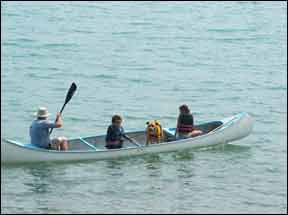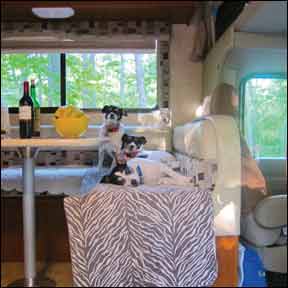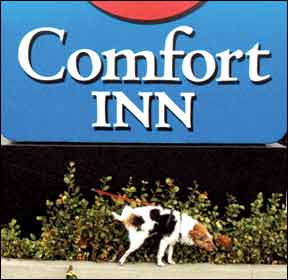[Updated October 30, 2017]
For some of us, taking a vacation just wouldn’t be nearly as much fun if we couldn’t share it with our dogs. Camping and other outdoor adventures are natural vacation options with our four-legged friends, although dog-friendly vacations can be as plush as a four-star hotel stay! Depending on you and your dog, your perfect dog-friendly vacation might mean a visit with your favorite aunt and uncle, sightseeing in your favorite historical town, long days hiking and swimming, or simply snoozing in a hammock on your favorite beach.

While taking your dog on vacation can be great fun, it can also pose some challenges. Not every dog (or person, for that matter) will enjoy a visit to a crowded tourist destination. Not every relative will appreciate having us show up on their doorstep with our dog in tow. And some dogs just aren’t cut out for rugged camping adventures. Plus, some dogs become over-excited or anxious when traveling, which can lead to things like marking, barking, or destructive behavior. These won’t make for the most relaxing vacation experience!
So how can you make sure that you have a fun-filled, happy vacation that includes your dog, and a dog who loves to vacation with you? It all starts with realistic expectations and being prepared.
When you think about vacationing with your dog, you may already have a destination, such as a visit with your favorite aunt or a trip to a national forest. If you’re still considering your options, a quick Google search will reveal thousands of dog-friendly vacationing opportunities: camping, cabins, resorts, hotels and motels, beaches, dog camps, and even canoeing and boating trips. But which will you and your dog really enjoy?
To avoid a lot of “pre-training” for what you know will probably be a one-time experience, you may want to choose a get-away that brings you the experience you desire, while still taking into account your dog’s personality. Consider some of these dog-related questions when thinking about your vacation:
-Does your dog like adventure and excitement? Or would she be happier with a calm, quiet experience?
-Is your dog a seasoned traveler? Or will this experience be all new?
-Does your dog enjoy people? Other dogs?
-Does your dog have any special needs or physical limitations that might affect her enjoyment of a trip?
How will thinking about these questions help? If your dog is a social butterfly, and you both love the bustle of people and activity, for example, you might choose a dog-friendly resort area or city.
In contrast, if your dog is shy of people or likes to run and swim, you might choose a quiet week in a lake-front cabin instead. Keeping your dog’s personality and experience in mind will help you plan a fun vacation for you both.
Dogs Allowed or Dog-Friendly?
Once you have a specific type of trip in mind, it’s time to do a little research. For most vacation destinations, you can find options that will allow dogs. But there is a vast difference between a place that simply allows pets and one that is truly pet-friendly.

Some tourist destinations, for example, allow dogs in hotels, campsites, and parking areas, but not when visiting the actual attractions. We found that out one year when visiting a state park. Our dogs were allowed in our campsite and the parking lot areas, but not on the trails that led to the river, beach, or redwoods.
In contrast, a friend recently returned from a tour of art galleries in Santa Fe, New Mexico. Their accommodations were welcoming of their young German Shepherd, but Cassie was also invited into every gallery they visited. Plus the city boasts a large off-leash dog park and walking area. Both dog and humans had a wonderful vacation and plan to return in the near future.
When making your vacation plans, call or query ahead and ask to make sure that what they consider “pet-friendly” really does meet your canine’s needs. Check out these 5 Tips for Staying in a Hotel With Dogs from Dogster.com to make sure you know exactly what to expect.
-Are dogs allowed in the hotel, motel, or campground?
-Are there size or breed restrictions?
-Are there restrictions on the number of dogs you can have?
-Is there an extra charge or a cleaning fee for dogs?
-Are dogs required to be on-leash?
-Are there dog-friendly parks in the area? What about off-leash parks or beaches?
-Are dogs allowed on walkways, paths, or trails? In city or downtown areas? On sidewalks? In stores, galleries, wineries, or other locals attractions?
-Do I need proof of vaccinations or a health certificate?
Keep in mind that there are no right or wrong answers here. Some people may really want to visit a place where their dog can romp off-leash, while for others that isn’t as important, or could even be a deterrent. The answers to these questions will help you assess if this is the right place to take your dog.
Preparing for Travel with Dogs
Travel is a huge part of many vacations. My vacations usually involve car and foot travel (i.e., walking and hiking), but I have friends who have ridden bicycles across the country with their dogs, and know others for whom canoeing and kayaking are important parts of their dog-friendly vacations.
The most important thing to consider about traveling with your dog is how accustomed he or she is to the type of travel you will be doing. Is your dog comfortable in the car or canoe? Can you take steps ahead of time to help him become more comfortable?
If traveling by car or recreational vehicle, make sure your dog is relaxed on longer rides, doesn’t get car sick, and knows how to settle down. To make it even more pleasant for your dog, plan to make frequent stops to stretch, play, and potty.
If your vacation involves walking, hiking, or backpacking, make sure your dog is in good enough shape to handle your walking expectations. In addition, make sure his or her pads are toughened up for new terrain or have him habituated to wearing booties to protect his feet.
Bike and boat travel with dogs usually involves dogs riding in a specific spot, carrier, or cart. Similar to traveling by car, your dog will need to be comfortable in the particular vehicle and know how to settle in for the ride.

Are you considering public transportation as part of your travel plans? Depending on where you live and the type of travel you are doing, this may or may not be an option. For example, in the U.S., Amtrak trains and Greyhound buses do not allow dogs, with the exception of service dogs. But some trains in other countries do. Do your homework ahead of time to find out the rules.
Prepare for “Dog Time”
Some vacations involve continual travel or moving from place to place. Others are about getting to and enjoying a single destination. But either way, your vacation will mean a lot of together time with your dog. This is where a whole set of “do’s and don’ts” come into play.
Do plan to have your dog with you all of the time. Your dog will need to be with you or one of your traveling companions at all times.
Don’t leave your dog alone in a hotel room or campsite (most places don’t allow it, and even if they do, many dogs will be completely freaked out at being left in a strange, new place).
Don’t leave your dog alone in the car while you play tourist. Even in the shade, even with the windows down, leaving dogs in cars can be very dangerous. On a 75 degree day, for example, the temperature inside of a car can reach 120 degrees in 30 minutes or less. This can put your dog at risk for heat stroke and death. Cold is equally problematic. In cold or snow, your car can become a refrigerator in a matter of minutes. Plus, dogs can be stolen from cars when left unattended.
If you are staying in one place (say a rental cabin or a family member’s home) for more than a few days, Do condition your dog to staying in this new place for short periods of time. It’s easiest to do this with dogs who are crate trained or already accustomed to visiting places other than your home.
Some tourist destinations also have day kennels where you may be able to leave your dog while you visit the sights, but Do check out any kennel carefully to make sure it is a safe and appropriate place for your dog.
Not being able to leave your dog does limit how you will travel and what you can do. But it also opens up opportunities to do more fun things with your dog. For example, you can find great dog-friendly restaurants with outdoor seating, or get take-out and have a picnic at a nearby park or riverbank. While you may not be able to hike that national park trail, you probably can hike an equally beautiful trail in a neighboring national forest. An outdoor art exhibit or private gallery may allow your dog even if the county museum does not.
Train Your Dog Along the Way
Like with everything in the life of a dog, a little training can really pay off in the long run. Some behaviors are especially helpful when it comes to traveling.
Anke Van Wyk | Dreamstime.com

Eliminating on cue (“Go potty” or “Get busy”) may be one of the more important things you can teach a dog with whom you would like to vacation! A dog’s house-training may or may not travel with him to a new place. Dogs tend to learn where to go at home and the places they visit regularly, but they won’t know when you first step out of your car in a new city or town where the appropriate toilet spot is located. When you teach them to eliminate on cue, you have a huge step up to helping them learn to go when and where you want them to go (like in a posted potty area rather than the hotel flower garden, or worse yet, the lobby planter!).
Here’s how to get this behavior on cue:
1. Pick a word or cue such as “go potty” or “get busy.”
2. For about a week, every time you see your dog about to pee or poop, say “get busy” or your cue. This will begin creating an association between the words and the action. When the dog finishes, praise or give a reward.
3. Once your dog seems to be making the connection between the cue and eliminating, try asking your dog to “get busy” when you know he needs to, but isn’t yet about to do it. Does your dog look for a place and make it happen? If so, you’ve successfully created an association, and you can use it in new places.
4. Keep rewarding your dog until he has it down! Now, when you get to a new place, you can take your dog to a designated potty area and say, “get busy.”
Along with teaching an elimination cue, you can help your dog understand where to go by doing the following:
–Give him the chance to relieve himself as soon as you arrive at a new place.
–Take your dog out regularly, much as you would a puppy. Praise or reward him for going in an appropriate spot.
–Don’t expect your dog to know how to “ask” in this new place. And certainly don’t expect him to find the potty spot on his own until you have been in a place several days and it is well established.
–Is your dog a marker? If so, keep a very close eye on him in the first hours or days in a new place. Interrupt marking behavior immediately and take him to a designated potty area.
Other behaviors that can help your dog have a great vacation include:
Coming when called. This is a critical safety skill. If your dog gets loose in a new environment, he can easily become disoriented. Knowing to come back when called is even important for dogs who will be kept on-leash. You just never know when a dog will become upset or freaked out and take off unexpectedly.
Settle on their bed or in their crate. If your dog knows how to settle, then you can use this behavior when you are dining in an outdoor restaurant or when you are ready to relax back at the hotel room. If you are visiting family, your dog may be more likely to be invited back if he can settle quietly during dinner or at the end of a busy social day.
Say hello. During travel, you will likely run into unfamiliar people. Teaching your dog the important skill of greeting strangers can really help your dog’s comfort level in a new place.
Loose-leash walking. Leashes are almost always required at some point during a vacation, and you’ll both have a lot more fun if your dog isn’t dragging you around.
When you are embarking on a new experience with your dog, training ahead will help. But keep in mind that for a novice traveling dog, you will likely need to do some training along the way, too.

For example, one of my dogs started off his first camping adventure afraid of night noises. The first few nights of our camping trip were not much fun at all. I was awake, working with him to understand that the night rustles and owl hoots really weren’t anything to be concerned about. But after that initial training, he became a great camping dog – knowing what to ignore, and when to alert. Giving up a little sleep in order to train paid off big time for years of camping adventures.
Doggy Packing List?
When getting ready to pack for yourself, your decisions will be influenced by where you will be staying, the weather, and what activities you will be enjoying. Consider the same things when deciding what to bring for your dog. The basics include food, water, and bowls, treats, poop bags, and a leash, but your list may expand depending on the type of vacation you are taking.
If your dog will have the opportunity to get wet, muddy, or covered with burrs and ticks, bring dog towels (and dog shampoo?), a brush, flea comb, and tick remover. For a hotel stay, bringing a comfy crate and an extra sheet or blanket to protect your bed would be more appropriate.
One of the most important things to consider for your dog is identification. Make sure your dog wears a well-fitting collar with current ID tags or nameplate. Even if your dog does not wear a collar or tags at home, it is critical should you become separated during your travels. Make sure the ID has a phone number that can be reached on your travels – ideally, your cell number.
A microchip is also a very good idea for all dogs, but especially when you take your dog on a trip. Most shelters and veterinary emergency hospitals have scanners and will check for a microchip should your dog become lost. This is one time when planning for the worst is essential!
In some cases, for example if you are crossing state or national borders, you may need to have health certificates or proof of vaccines with you. Some parks or camp areas may also require proof of rabies or other vaccinations. Check ahead to make sure you have the paperwork you need.
For your dog’s comfort, always bring along some things that are familiar. A favorite bed or blanket or a cozy sleeping kennel are ideal. Having a familiar bed or blanket can really help your dog understand that where you are, he belongs! And if your dog has been taught to settle on his bed, he will also know where to take a break from the excitement of your travels. Favorite toys can also help.
Think about confinement tools, too. A crate for sleeping or traveling in the car is great, but you might want to consider other types of confinement as well. For example, if you are car camping, your dog may be required to be on-leash at all times in the campground. But if you’re cooking over an open fire, you will not want to hold on to your dog’s leash. A cable tie-out or an exercise pen may be good options for hanging out around the camp. Of course you will need to be with your dog and supervise if he is on a tie-out or in a pen, but your hands will be free for other activities.
Finally, think about what you’ll need, and then come up with a similar list for your dog. Will you need sun protection? Then you might need to think about sun protection for your dog as well. Will it be cold enough for a jacket? Perhaps your short-haired dog will also relax more comfortably with a sweater or jacket. What about insect repellent? Will you encounter fleas, ticks, or mosquitoes during your travels? Are you taking along your boots for hiking or a life jacket for boating? Then your dog may benefit from foot protection and a flotation vest. What about a first-aid kit? Obviously, for some vacations, you won’t need all of these items, but be sure to consider all of the “what ifs.”
Enjoy Your Dog!
My vacation this year will be to our favorite place in Northern California, called The Other Place. The house we will rent sits on a ridge top above the town of Boonville. It has the perfect balance of creature comforts for me and my partner, and wild dog experiences for our young Queensland heeler-mix. Plus, it’s private and calm – a good match for my dog’s needs and personality. We’ll hike and play, she’ll swim in the pond, and we’ll all relax in a big hammock overlooking a beautiful valley, brimming with bird song. We will also take a trip to the coast, spend a day walking wwthe dog-friendly trails of the Mendocino Botanical Gardens, dine at outdoor restaurants, and probably picnic by the river, too.
This type of vacation is well suited for our dog, with the right balance of activity, calm and quiet, and just a touch of social interaction. Some day, I may have a very outgoing dog, and then I will plan a vacation to one of the great dog-friendly resorts, or perhaps spend a week at a dog camp playing agility with other dog-fanatics and their dogs. But for now, this trip will suit all of us perfectly and give us, well, a real vacation!





